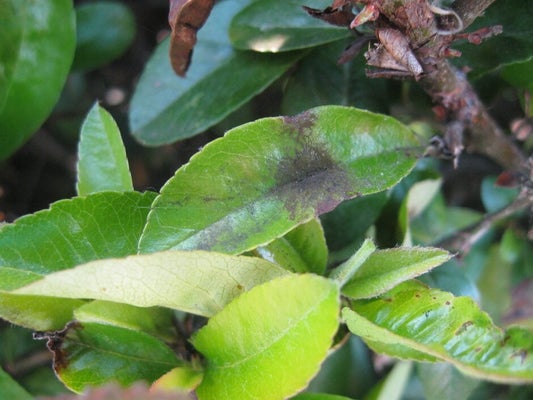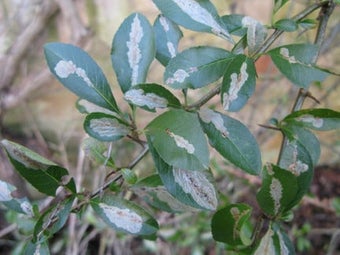
Quick facts
Common name - Pyracantha scab
Scientific name - Venturia inaequalis f. sp. pyracanthae
Plants affected - Pyracantha, Eriobotyra (loquat) and Mespilus (medlar)
Main symptoms - Dark spots on leaves, leaf fall, blackened flowers and fruit
Caused by - Fungus
Timing - from spring through to autumn
What is pyracantha scab?
Pyracantha scab is an infection of the blossoms, leaves and fruit of Pyracantha by the fungus Venturia inaequalis f. sp. pyracanthae, resulting in flower loss, leaf fall and disfiguring black lesions on the fruit. The fungus was formerly known as Spilocaea pyracanthae but recent work demonstrated that the scab fungi affecting apple and pyracantha belong to the same species. Venturia inaequalis includes subpopulations that can only infect specific plant genera; therefore, the form that affects apple does not affect pyracantha and vice-versa. However, the scab fungus that affects Pyracantha also attacks Eriobotrya (loquat) and Mespilus (medlar) to a lesser extent.
You will see scab from spring until autumn.
Symptoms
You may see the following symptoms:
- On leaves: Infection appears initially as dark spots on the leaf surface. Infected leaves soon fall and a severe attack can extensively defoliate the plant
- On flowers: Infected flowers shrivel and blacken, and do not form fruit
- On fruit: Disfigured, blackened areas and cracking of the surface
- On shoots: Young shoots may die back
The symptoms on shoots can be similar to those of fireblight, but fireblight infection on Pyracantha is more sudden and severe than scab.

Control
The RHS believes that avoiding pests, diseases and weeds by good practice in cultivation methods, selection, and encouraging or introducing natural enemies, should be the first line of control. If chemical controls are used, they should be used only in a minimal and highly targeted manner.
Non-chemical control
- Hygiene is important for control, since the fungus survives winter on infected fallen leaves, infected fruits and pustules on infected stems. Rake up and burn fallen leaves, or consign them to the local council collection. Cut back infected parts to remove mummified fruits and stem infections. Note that rigorous cutting back will reduce flowering the following year
- Choose resistant plants. The Saphyr® range and ‘Golden Charmer’, ‘Shawnee’ and ‘Teton’ are all claimed to show some resistance to pyracantha scab
Fungicides
The RHS recommends that you don't use fungicides. Fungicides (including organic types) may reduce , impact soil health and have wider adverse environmental effects. If you do intend to use a fungicide, please read the information given in the link and download below to ensure that use, storage and disposal of the product is done in a responsible and legally compliant manner.
The products listed in the ‘Fungicides for gardeners’ document below are legally available for use by home gardeners in the UK. This information is provided to avoid misuse of legal products and the use of unauthorised and untested products, which potentially has more serious consequences for the environment and wildlife than when products are used legally. Homemade products are not recommended as they are unregulated and usually untested.
There is no specific information available on the efficacy of any home garden fungicide against pyracantha scab.
Download
Fungicides for gardeners (Adobe Acrobat pdf document outlining fungicides available to gardeners)
Link
Biology
The cause of scab on Pyracantha is the fungus Venturia inaequalis f. sp. pyracanthae. The fungus overwinters on fallen leaves and probably also on shrivelled fruit remaining on the plant and in pustules on the stems, then releases spores to reinfect new growth in spring. The spores of Venturia inaequalis f.sp. pyracanthae are dispersed mainly in water and to a limited extent by wind, so the disease is more severe under wet conditions.










